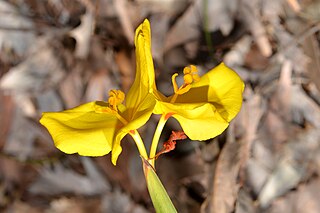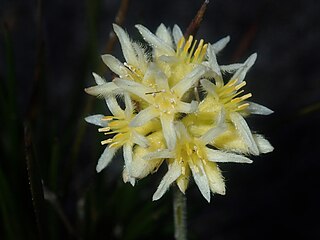
Conostylis setigera, commonly known as bristly cottonhead, is a rhizomatous, tufted perennial, grass-like plant or herb in the family Haemodoraceae and is endemic to the south-west of Western Australia.

Conostylis pusilla is a rhizomatous, tufted perennial, grass-like plant or herb in the family Haemodoraceae, and is endemic to the south-west of Western Australia. It has flat leaves and hairy yellow flowers usually arranged in pairs on a flowering stem.
Patersonia limbata is a species of plant in the iris family Iridaceae and is endemic to the south of Western Australia. It is a tufted, rhizome-forming herb with sword-shaped, bordered leaves and violet tepals.
Patersonia rudis, commonly known as hairy flag, is a species of plant in the iris family Iridaceae and is endemic to the south-west of Western Australia. It is a tufted, rhizome-forming perennial herb with linear to sword-shaped leaves and violet tepals.

Patersonia umbrosa, commonly known as yellow flags, is a species of plant in the iris family Iridaceae and is endemic to the south-west of Western Australia. It is a loosely-tufted, rhizome-forming, perennial herb with linear to sword-shaped leaves and deep bluish-violet or bright yellow tepals.

Johnsonia acaulis is a plant in the family Asphodelaceae and is endemic to the south-west of Western Australia. It is a rhizomatous, tufted, or grass-like perennial with white, pink or green flowers.

Johnsonia teretifolia, common known as hooded lily, is a plant in the family Asphodelaceae and is endemic to the south-west of Western Australia. It is a rhizomatous, tufted, or grass-like perennial with white, pink or green flowers.

Conostylis drummondii is a rhizomatous, tufted perennial, grass-like plant or herb in the family Haemodoraceae and is endemic to the south-west of Western Australia. It has short stems, and has more or less cylindrical leaves and pale lemon-yellow flowers.

Conostylis festucacea is a rhizomatous, tufted or proliferous perennial, grass-like plant or herb in the family Haemodoraceae, and is endemic to the south-west of Western Australia. It has cylindrical or flat leaves and yellow flowers.

Conostylis juncea is a rhizomatous, tufted perennial, grass-like plant or herb in the family Haemodoraceae, and is endemic to the south-west of Western Australia. It has cylindrical or flat leaves and yellow flowers on a short flowering stem.

Conostylis misera, commonly known as grass conostylis, is a prostrate, rhizomatous, tufted perennial, grass-like plant or herb in the family Haemodoraceae, and is endemic to the south-west of Western Australia. It has flat leaves and bright yellow flowers usually arranged singly on a short flowering stem.
Conostylis petrophiloides is a rhizomatous, tufted perennial, grass-like plant or herb in the family Haemodoraceae and is endemic to the south-west of Western Australia. It has flat, glabrous leaves, and yellowish-cream coloured, tubular flowers.

Conostylis phathyrantha is a rhizomatous, tufted perennial, grass-like plant or herb in the family Haemodoraceae and is endemic to the south of Western Australia. It has flat, glabrous leaves, and yellow, tubular flowers.

Conostylis prolifera, commonly known as mat cottonheads, is a rhizomatous, tufted, stoloniferous, perennial, grass-like plant or herb in the family Haemodoraceae and is endemic to the south-west of Western Australia. It has flat, glabrous leaves, and yellow and cream-coloured, tubular flowers.
Conostylis resinosa is a rhizomatous, tufted perennial, grass-like plant or herb in the family Haemodoraceae and is endemic to the south-west of Western Australia. It has flat, shiny leaves, yellow, tubular flowers and is similar to C. aurea.
Conostylis rogeri is a rhizomatous, tufted perennial, grass-like plant or herb in the family Haemodoraceae and is endemic to a small area in the south-west of Western Australia. It has small tufts, flat leaves, and a single pale yellow, tubular flower.

Conostylis seminuda is a rhizomatous, tufted perennial, grass-like plant or herb in the family Haemodoraceae and is endemic to a small area in the south-west of Western Australia. It has flat leaves and golden yellow, tubular flowers.

Conostylis teretifolia is a rhizomatous, tufted, perennial, grass-like plant or herb in the family Haemodoraceae and is endemic to the south-west of Western Australia. It has flat leaves, short stems and yellow to reddish, tube-shaped flowers.

Conostylis teretiuscula is a rhizomatous, tufted perennial, grass-like plant or herb in the family Haemodoraceae and is endemic to the south west of Western Australia. It has flat leaves and yellow, tube-shaped flowers.
Conostylis tomentosa is a rhizomatous, tufted perennial, grass-like plant or herb in the family Haemodoraceae and is endemic to the south-west of Western Australia. It has flat leaves with bristles of hairs on the leaf margins, and golden yellow, tubular flowers.














